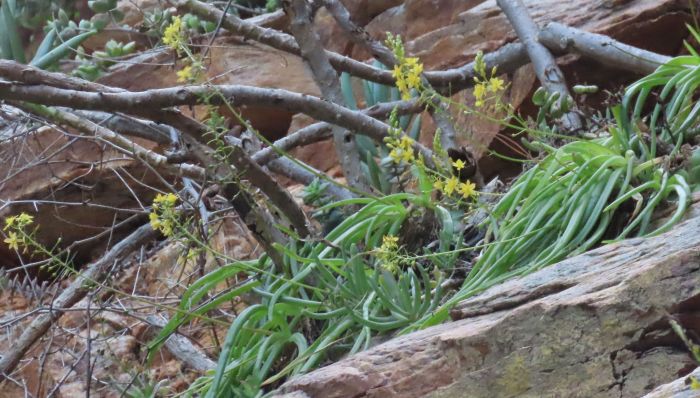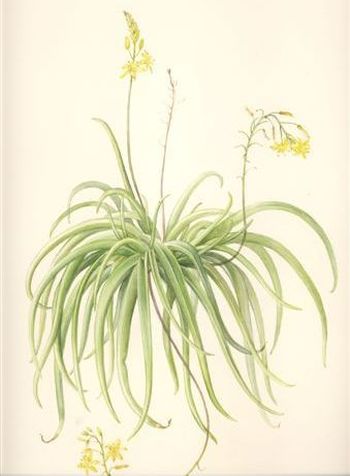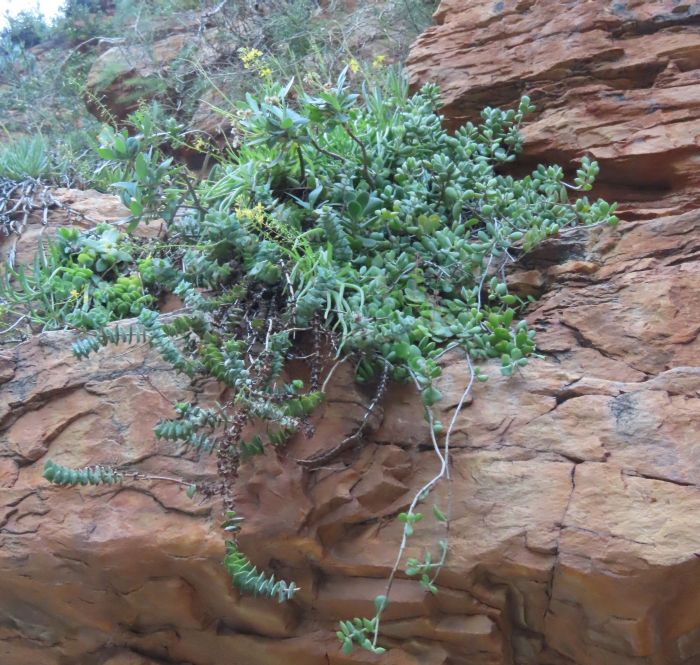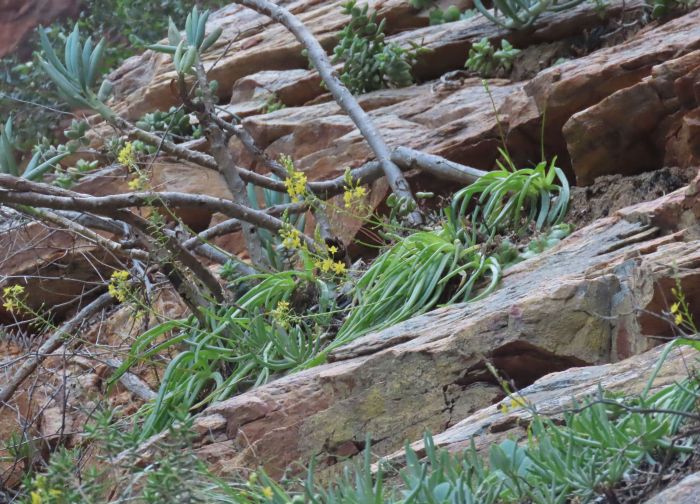Bulbine meiringii
Bulbine meiringii Van Jaarsv.
Family: Asphodelaceae
Common names: Meiringspoort bulbine (Eng.); Meiringspoortkopieva (Afr.)
Introduction
Bulbine meiringii is an obligate cliff-hanger, with soft, drooping leaves and solitary inflorescences bearing yellow flowers in spring. Plants hang from the quartzitic sandstone cliff faces in Meiringspoort, Western Cape. Best grown in containers and hanging baskets.

Fig. 1. Bulbine meiringii in flower in spring, growing on a sheer cliff ledge in Meiringspoort, near De Rust (Western Cape).
Description
Description
Dwarf succulents growing up to 100 mm high, with leaves in loose rosettes. It divides to form clusters about 200 mm in diameter, with up to 12 heads. The roots are grey, fleshy, terete, slightly fusiform, up to 3 mm in diameter. The tuber is oblong, terete, 20–35 x up to 10 mm, slightly thickening towards the base, covered with persistent fibrous tunics. The leaves, 4 to 7, curving downwards, the leaf blade glaucous, linear-lanceolate, almost subterete when fully turgid, 80–210 x 6–8 mm; adaxial side flat to convex, abaxial side convex, striate; apex acute, margins denticulate.

Fig. 2. The Meiringspoort bulbine (Bulbine meiringii) illustration by Vicki Thomas.
The inflorescence solitary, 210–260 mm tall, ascending to spreading; flowers lax, borne in the distal third, about 14 mm in diameter, 4–6 mm apart; peduncle up to 3 mm wide at base, biconvex, terete distally; bracts deltoid-acuminate, 3–4 mm long, about 1 mm wide at base, membranous, clasping; pedicels 10–12 mm long. Perianth stellate, becoming reflexed; tepals pale yellow, outer tepals elliptic, up to 7 x 2 mm, apices obtuse, inner tepals ovate to ovate-elliptic, up to 6 x 2.5–3.0, apices obtuse. Stamens up to 5 mm long; anthers yellow, oblong, dorsifixed. Ovary globose, up to 1.5 mm in diameter; style erect, up to 5 mm long; stigma capitate. Capsule ovoid, up to 3 x 4 mm. Seeds up to 1.5 x 1 mm, grey-black. Flowering occurs in spring.

Fig. 3. The Meiringspoort bulbine (Bulbine meiringii) growing on a a sheer cliff ledge (left) and on a steep embankment (right) in Meiringspoort during a dry summer.
Conservation Status
Status
Although the population is as yet only known from a single habitat northeast of Oudtshoorn, it grows on cliffs and is thus well protected by its difficult to reach habitat and its distribution range falls within a greater conservation region. Consequently it is assessed as Least Concern (LC) in the Red List of South African Plants.

Fig. 4. Bulbine meiringii shares its habitat with many cliff-dwelling (cremnophilous) species such as Crassula pellucida subsp. marginalis, Crassula perforata, Senecio muirii, Curio ficoides & Cotyledon woodii.
Distribution and habitat
Distribution description
Bulbine meiringii is known only from Meiringspoort, near De Rust in the Little Karoo, Western Cape. It grows on sheer, south-facing, quartzitic sandstone cliff faces, where they form small clusters at an altitude of 500–800 m. The average daily maximum temperature is about 26ºC and the average annual minimum about 9ºC. Rainfall occurs in winter and summer, ranging from 200–300 mm per annum, and frost is absent or very light. The associated vegetation is Western Gwarrieveld of the Succulent Karoo Biome (Mucina et al. 2006). Associated cliff-dwelling succulents include Adromischus triflorus, Crassula perforata, C. pellucida subsp. marginalis and C. rupestris, Cotyledon woodii, Haworthia sp., Curio ficoides and Senecio muirii.
Plants grow on quarzitic sandstone rock ledges of the Peninsula Formation, Table Mountain Group (Cape Supergroup). These cliff ledges have many fissures, ledges and crevices, which make them ideal for the establishment of plants.

Fig. 5. Sheer south-facing cliffs along the Meiringspoort, the habitat of Bulbine meiringii. Phillip Venter standing among the plants on the cliff ledge
Derivation of name and historical aspects
History
Bulbine meiringii was named by the author in the magazine Aloe in 2003 and was named for its habitat, Meiringspoort.
Bulbine meiringii is characterised by its oblong tubers with slightly fusiform roots and by the slender, linear-lanceolate, glaucous leaves. It can perhaps be confused with B. cremnophila, which has much shorter and fleshier leaves, and lacks the oblong tuber and fusiform roots. Bulbine meiringii is also closely related to B. rupicola occurring further east (Eastern Cape Province) and growing in rock crevices. The latter has ovoid tubers and short, ascending, green, somewhat channelled leaves.
Ecology
Ecology
Plants grow in a relatively safe cliff-face environment from which larger herbivores are absent and it is also partially protected from fires. The flowers are pollinated by insects and the fruiting capsule ripens in summer, and seed is dispersed by wind. The drooping nature of the stems and leaves is an adaptation to its cliff face habitat. The succulent nature of the plant (leaves, stems and roots) enables the plant to cope during the dry season.

Fig. 6. A group of Meiringspoort bulbine (Bulbine meiringii) in flower during spring, growing on a ledge at Meiringspoort. Note the Curio ficoides sharing its habitat.
Uses
Use
No cultural or medicinal uses have been recorded.
Growing Bulbine meiringii
Grow
Bulbine meiringii can be grown with relative ease from either seed or dividing the plants. It is a habitat specialist and consequently better to keep as a containerized plant, such as growing it in a hanging basket or as a pot plant, best on a balcony or windowsill where the leaves can become pendent. Plants grow relatively fast and can also be planted on a steep south facing embankment (southern hemisphere) protected from root competition of other plants. The young plants start solitary, and the rosettes divide forming small, dense clusters.
The soil should be sandy and well-drained, as is found in its natural habitat. They will react to any fertiliser but organic fertilisers are best, such as compost (well broken down). The plant should be watered during winter and summer.
Divide plants at any time of the year, and plant in a shallow tray in a sandy mixture (peat, sand and polystyrene) and keep moist. Rooting is within 3 weeks and once well rooted transfer to individual containers. Place container in a shady position but with full light. The south side of a building is ideal.
Sow seed in spring or summer in a sandy medium. First moisten the substrate with fine rose spray. Cover the seed lightly with a thin layer of sand. Keep moist and in a shady position. Germination is usually within 3 weeks and the young seedlings are relatively fast growing. Transplant seedlings to individual containers once large enough to handle.
Plants are relatively disease free but snails can cause a problem. They should reach flowering size within a year.
References
- Van Jaarsveld, E.J. & Van Wyk, A.E. 2003. Four new cliff-dwelling Bulbine taxa (Asphodelaceae) from the Eastern and Western Cape. Aloe 40(1): 4–7.
- Manyama, P.A. & Kamundi, D.A. 2006. Bulbine meiringii Van Jaarsv. National Assessment: Red List of South African Plants version 2020.1. Accessed on 2021/02/17
Credits
Ernst van Jaarsveld
Kirstenbosch National Botanical Garden (Retired 2015)
Babylonstoren Farm
Extraordinary senior lecturer and researcher,
Department of Biodiversity and Conservation, University of the Western Cape
March 2021
Plant Attributes:
Plant Type: Succulent
SA Distribution: Western Cape
Soil type: Sandy
Flowering season: Spring
PH: Acid, Neutral
Flower colour: Yellow
Aspect: Shade, Morning Sun (Semi Shade)
Gardening skill: Average
Special Features:
Horticultural zones









Rate this article
Article well written and informative
Rate this plant
Is this an interesting plant?
Login to add your Comment
Back to topNot registered yet? Click here to register.